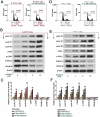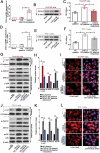Activation of CXCL5-CXCR2 axis promotes proliferation and accelerates G1 to S phase transition of papillary thyroid carcinoma cells and activates JNK and p38 pathways
- PMID: 30404567
- PMCID: PMC6606038
- DOI: 10.1080/15384047.2018.1539289
Activation of CXCL5-CXCR2 axis promotes proliferation and accelerates G1 to S phase transition of papillary thyroid carcinoma cells and activates JNK and p38 pathways
Abstract
C-X-C motif chemokine ligand 5 (CXCL5) is initially identified to recruit neutrophils by interacting with its receptor, C-X-C motif chemokine receptor 2 (CXCR2). Our prior work demonstrated that the expression levels of CXCL5 and CXCR2 were higher in the papillary thyroid carcinoma (PTC) tumors than that in the non-tumors. This study was performed to further investigate how this axis regulates the growth of PTC cells. B-CPAP cells (BRAFV600E) and TPC-1 cells (RET/PTC rearrangement) expressing CXCR-2 were used as in vitro cell models. Our results showed that the recombinant human CXCL5 (rhCXCL5) promoted the proliferation of PTC cells. rhCXCL5 accelerated the G1/S transition, upregulated the expression of a group of S (DNA synthesis) or M (mitosis)-promoting cyclins and cyclin-dependent kinases (CDKs), and downregulated CDK inhibitors in PTC cells. The CDS region of homo sapiens CXCL5 gene was inserted into an eukaryotic expression vector to mediate the overexpression of CXCL5 in PTC cells. The phosphorylation of c-Jun N-terminal kinases (JNK) and p38, and the nuclear translocation of c-Jun were enhanced by CXCL5 overexpression, whereas attenuated by CXCR2 antagonist SB225002. Additionally, CXCL5/CXCR2 axis, JNK and p38 pathway inhibitors, SB225002, SP600125 and SB203580, suppressed the growth of PTC cells overexpressing CXCL5 in nude mice, respectively. Collectively, our study demonstrates a growth-promoting effect of CXCL5-CXCR2 axis in PTC cells in vitro and in vivo.
Keywords: CXCL5; CXCR2; JNK pathway; cell cycle; cell proliferation; p38 pathway; papillary thyroid carcinoma.
Figures





References
-
- Chang MS, McNinch J, Basu R, Simonet S. Cloning and characterization of the human neutrophil-activating peptide (ENA-78) gene. J Biol Chem. 1994;269:25277–25282. - PubMed
MeSH terms
Substances
LinkOut - more resources
Full Text Sources
Medical
Research Materials
Miscellaneous
